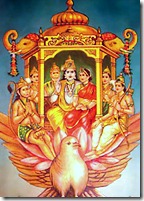 “O Sita, see the golden lord of mountains [Mainaka], which is golden-peaked and which rose up, piercing the ocean, to provide rest to Hanuman.” (Lord Rama speaking to Sita Devi, Valmiki Ramayana, Yuddha Kand, 123.18) “O Sita, see the golden lord of mountains [Mainaka], which is golden-peaked and which rose up, piercing the ocean, to provide rest to Hanuman.” (Lord Rama speaking to Sita Devi, Valmiki Ramayana, Yuddha Kand, 123.18)
hiraṇyanābhan śailendran kāñcanaṃ paśya maithili ||
viśramārthan hanumato bhittvā sāgaramutthitam |
Lord Rama, the victorious son of King Dasharatha, having just slain His enemy who had unrightfully taken His religiously wedded wife away from Him, was riding home in the aerial car known as the Pushpaka. An arduous many months had just culminated with the rescue of His wifeSita Devi, and now came the time to go back home, to return to His land where He had not been for fourteen years. The last memories Rama had of that place were from the day He was almost crowned as the new king, with His father King Dasharatha ready to hand the throne over to Him, as He was the eldest son. Fourteen years having passed and Dasharatha having quit His body, Rama would return home nonetheless. He would be received with a tremendous welcome consisting of so many lights that the occasion became celebrated thereafter as Diwali or Deepavali, which means a row of lamps. On the way home, Shri Rama, happy to be reunited with His wife, pointed out to her a collection of important places which were soon to become sacred pilgrimage sites. Always mindful of the services offered to Him, Rama even noted the important areas relating to His dearmost servants, which included the best of them all, Shri Hanuman.
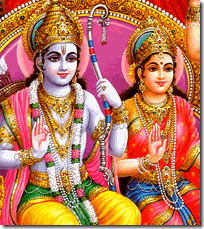 If you haven’t seen one of your closest friends for a while, when you do actually meet up with them, you’ll want to know what they have been up to. “What have you been doing? What did you do for such and such occasion? How are your friends and family doing?” With Sita, her meeting with Rama piqued an even stronger interest, for she had been held captive in a tucked away grove of Ashoka trees for many months. The wicked ruler of the island kingdom of Lanka had taken her away from the side of her husband and then threatened to kill her if she didn’t give in to becoming his wife. Lord Rama is the Supreme Personality of Godhead in the guise of a human being, someone who is spiritual in every way. The fact that Rama is still celebrated to this day and His glorious qualities and activities still studied and taken delight from shows that He is no ordinary human being. The shastras already reveal to us Rama’s divinity, but as if we needed further convincing, annual occasions like Diwali remind us that Rama is God not only based on His own displays of strength and valor, but also from the merits of His associates, who substantiate the Lord’s supreme position with their every act. If you haven’t seen one of your closest friends for a while, when you do actually meet up with them, you’ll want to know what they have been up to. “What have you been doing? What did you do for such and such occasion? How are your friends and family doing?” With Sita, her meeting with Rama piqued an even stronger interest, for she had been held captive in a tucked away grove of Ashoka trees for many months. The wicked ruler of the island kingdom of Lanka had taken her away from the side of her husband and then threatened to kill her if she didn’t give in to becoming his wife. Lord Rama is the Supreme Personality of Godhead in the guise of a human being, someone who is spiritual in every way. The fact that Rama is still celebrated to this day and His glorious qualities and activities still studied and taken delight from shows that He is no ordinary human being. The shastras already reveal to us Rama’s divinity, but as if we needed further convincing, annual occasions like Diwali remind us that Rama is God not only based on His own displays of strength and valor, but also from the merits of His associates, who substantiate the Lord’s supreme position with their every act.
Try to imagine the most beautiful woman in the world and you’ll get a slight idea of Sita Devi’s appearance. One way that the Vedas, the ancient scriptures of India, describe God is to say that He is the source of all energies. He is also the most fortunate living entity; hence He is known as Bhagavan. One of these fortunes involves having the most beautiful consort by your side. It would make sense then that Rama’s wife would be lacking nothing in terms of beauty. Since having her company is one of the greatest rewards in life, she is known as the goddess of fortune. Since God is married to the goddess of fortune, He is known by such names as Shripati, Shrinatha, Madhava, Lakshmipati and Sitapati.
Based on the definitions of Rama’s names, Sita cannot be with any other man. It is simply not possible. During her marriage ceremony on earth, many kings came to Janakpur to try to raise the bow handed down by Lord Shiva, which would earn them Sita’s hand in marriage. Yet only Shri Rama could lift the bow, as He is the only person worthy of being Sita’s husband. The external events always seem to be manageable, that if we can just manipulate things a certain way we’ll achieve our end. The Lord’s constitutional position, however, is absolute. As spirit souls, we too are knowledgeable, blissful and eternal, but our brilliant qualities can be covered up from time to time based on the type of body we assume. Hence we go through temporary ups and downs, gains and losses. With Rama there is never a loss. Even when it seems otherwise, Rama will rise to the challenge and maintain His constitutional position as the supreme enjoyer and husband of the goddess of fortune.
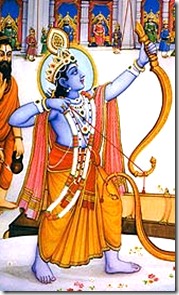 As if having learned nothing from the contest in Janaka’s kingdom, Ravana thought he could have Sita even after she was married to Rama. He took her away through a backhanded plot, for he couldn’t survive in a fair fight against Rama. Ravana was proud of his strengths achieved through pleasing divine figures, but he liked his opulence and good standing too much to try to jeopardize them by fighting with someone who he was told could defeat him. Thinking that by taking Sita away Rama would then wallow in despair and not continue to fight, Ravana figured he was safe in Lanka. As if having learned nothing from the contest in Janaka’s kingdom, Ravana thought he could have Sita even after she was married to Rama. He took her away through a backhanded plot, for he couldn’t survive in a fair fight against Rama. Ravana was proud of his strengths achieved through pleasing divine figures, but he liked his opulence and good standing too much to try to jeopardize them by fighting with someone who he was told could defeat him. Thinking that by taking Sita away Rama would then wallow in despair and not continue to fight, Ravana figured he was safe in Lanka.
Little did Ravana know that Rama doesn’t work alone. Just as the rewards of karma come to the worker at the right time -similar to how the trees blossom in season - Ravana’s punishment and Rama’s reunion with Sita were in the works as soon as the beautiful princess was taken away. Though the odds seemed stacked against Rama - as He was roaming the forest with only His younger brother Lakshmana by His side while Ravana had a massive army in Lanka - the Lord is never bereft of accompanying divine associates. He can even take monkeys and turn them into devoted fighters. Ironically enough, that’s exactly what He would do.
How did this transformation happen? As a touchstone turns iron into gold, communion with the divine consciousness turns an individual from any species into a surcharged soul capable of carrying out their devotion to the Supreme Lord. The Vanaras in the kingdom of Kishkindha were guaranteed of success in their mission simply based on their desire to serve Rama. The most capable Vanara was Hanuman, and he would play an integral role in Sita’s rescue. The first step in Ravana’s demise was learning where he was living, which meant finding where Sita was. It wasn’t even known for sure if Ravana had taken her or if Sita was still alive. Therefore a search party had to be sent out to scour the earth, to leave no stone unturned.
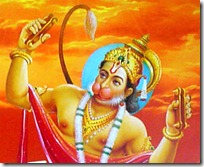 Sugriva, the leader of the monkeys in Kishkindha, dispatched his massive monkey army to perform this task, while in the back of his mind he knew that only Hanuman would be able to succeed. Sure enough, the burden would fall upon Hanuman to leap to the island of Lanka once it was learned that Sita was there. Not having an aerial car with him, Hanuman’s only option was to jump from a mountaintop and fly across the ocean. Since he was carrying out Rama’s work, the celestials in the sky and other powerful figures around the scene watched with rapt attention. The ocean personified was one such onlooker, and he wanted to help Hanuman. The ocean had a link to the Ikshvaku dynasty, the family in which Rama appeared. Hanuman was helping Rama, thus the ocean felt that it should help out someone who was doing work on behalf of the Ikshvakus. Whoever would help Hanuman would also play a part in the sacred sequence of events that would be celebrated for millions of years in the future. Sugriva, the leader of the monkeys in Kishkindha, dispatched his massive monkey army to perform this task, while in the back of his mind he knew that only Hanuman would be able to succeed. Sure enough, the burden would fall upon Hanuman to leap to the island of Lanka once it was learned that Sita was there. Not having an aerial car with him, Hanuman’s only option was to jump from a mountaintop and fly across the ocean. Since he was carrying out Rama’s work, the celestials in the sky and other powerful figures around the scene watched with rapt attention. The ocean personified was one such onlooker, and he wanted to help Hanuman. The ocean had a link to the Ikshvaku dynasty, the family in which Rama appeared. Hanuman was helping Rama, thus the ocean felt that it should help out someone who was doing work on behalf of the Ikshvakus. Whoever would help Hanuman would also play a part in the sacred sequence of events that would be celebrated for millions of years in the future.
The mountain Mainaka acted on behalf of the ocean. He was told to rise out of the ocean and act as a resting place for Hanuman during his journey. When Hanuman approached, Mainaka revealed what he had been told and how he would be supremely honored to offer at least some service to Hanuman, who was carrying out Rama’s business. Hanuman did not want any help though, for he was determined to fly ahead. Nevertheless, since he was asked so nicely, he honored Mainaka and the ocean by touching his hand on the top of the mountain and then proceeding on with his journey.
Shri Rama is antaryami, or the supreme witness, which means that He resides within the heart of every living entity. Therefore He knew what Hanuman was up to, but He still took great delight in hearing about his journey later on. On the trip home to Ayodhya, while riding in the aerial car Rama pointed out the mountain Mainaka to Sita and told her that this was where Hanuman was granted rest in his flight to Lanka. During this trip home, Rama had pointed out to Sita various places where Rakshasas had been killed and other things had taken place relating to her rescue. Sita was in captivity while the final battle was going on, so she really had no information of what transpired. Moreover, she had no idea where the notable events took place.
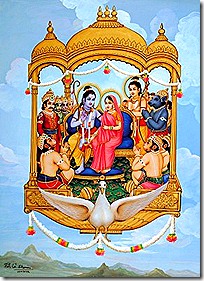 Rama knew that the victory was a team effort, and He was supremely pleased by the faithful dedication shown by the Vanaras, including Hanuman. For these reasons He thought that the specific locations relating to Hanuman were as important as those relating to His own achievements. From her own observations and the descriptions given to her by Rama, Sita could understand what the Vanaras had sacrificed, and how they were forever devoted to both she and her husband. When Rama later pointed out Kishkindha, Sita asked for the car to stop to pick up the wives of the monkeys, for Sita understood what it was like to be waiting somewhere while your husband was off fighting to the death with a powerful enemy. She wanted the chief Vanaras and their wives to accompany them on the journey home, where they would be ceremoniously greeted. Rama knew that the victory was a team effort, and He was supremely pleased by the faithful dedication shown by the Vanaras, including Hanuman. For these reasons He thought that the specific locations relating to Hanuman were as important as those relating to His own achievements. From her own observations and the descriptions given to her by Rama, Sita could understand what the Vanaras had sacrificed, and how they were forever devoted to both she and her husband. When Rama later pointed out Kishkindha, Sita asked for the car to stop to pick up the wives of the monkeys, for Sita understood what it was like to be waiting somewhere while your husband was off fighting to the death with a powerful enemy. She wanted the chief Vanaras and their wives to accompany them on the journey home, where they would be ceremoniously greeted.
Diwali reminds us of Rama’s triumphant return home and the wonderful service that the Vanaras provided. With Rama come Lakshmana and Sita, and also Hanuman and his many monkey friends. With a transcendental family like that, how can anyone who thinks of them ever feel alone? On the day where they lined up a row of welcoming lights, the faithful residents of Ayodhya would get to see their beloved Rama again, and they would get to hear of the events relating to His fourteen year exile and how Sita was eventually rescued. What they didn’t know was that their celebration would itself spark an ageless tradition, one that continues to this very day.
From the journey home and the celebration now known as Diwali, we see that any service rendered to Shri Rama or one of His servants never goes in vain. Every kind act is noticed by Rama Himself, and He takes so much delight from them that He shares His sentiments with Sita, taking great pleasure in being so honored. Therefore it was not surprising that the residents of Ayodhya would lay out a massive collection of lamps to welcome back their beloved Rama. That same Supreme Lord can eternally reside within our minds by regularly worshiping Him and His associates and chanting the holy names, “Hare Krishna Hare Krishna, Krishna Krishna, Hare Hare, Hare Rama Hare Rama, Rama Rama, Hare Hare”.
In Closing:
Shri Rama shows to Sita the mountain with golden peak,
Which gave rest to Hanuman while Lanka trying to reach.
The couple returning to Ayodhya, on the way home,
Flying in aerial car with closest friends, never alone.
Sita, captive in Lanka for months that were many,
So seeing places related to rescue made her happy.
Shri Rama Vanaras with Hanuman did help,
Their devotion to the Lord Sita could tell.
Therefore she was happy to see places of significance,
Relating to Hanuman, immeasurable in importance.
With the output of devotion Rama does not bother,
Looks for sincerity only, like Him no other.
Residents of Ayodhya had not seen Him for fourteen years,
Aligned rows of lamps when of His arrival they did hear.
Festival so grand that annual tradition it did spark,
To remember Rama’s arrival home, to please the heart.
|
Search This Blog
Wednesday, October 26, 2011
Diwali 2011
Subscribe to:
Post Comments (Atom)
No comments:
Post a Comment